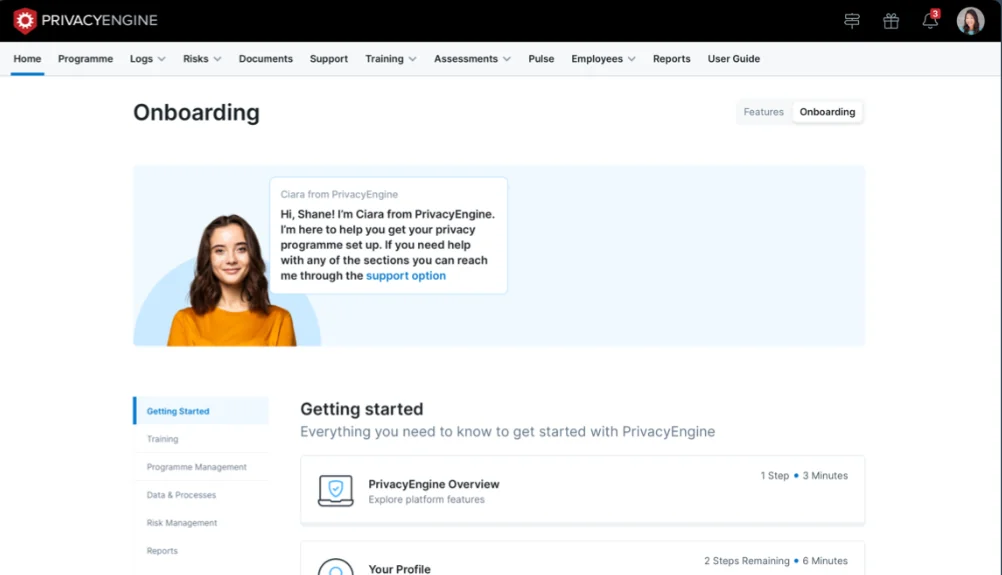Organizations face a significant challenge in safeguarding personal information amidst stringent data privacy regulations. It’s essential for them to proactively identify risks and adopt effective measures to protect sensitive data. A Data Protection Impact Assessment (DPIA) is a critical tool in this effort. However, navigating the complexities of conducting a DPIA can be daunting, especially without the right resources. This article delves into how organizations can effectively select DPIA tools tailored to their privacy needs.
Bonus Content: Download this blog post!
Understanding Data Protection Impact Assessments (DPIAs)
Data Protection Impact Assessment (DPIA) is a process to evaluate the risks to individuals’ privacy data. Essentially, DPIA is a tool that helps organisations assess the privacy impact of their data processing activities. Under GDPR, DPIA is mandatory for organisations processing any personal data that is likely to result in a high risk to the rights and freedoms of individuals. DPIA is designed to help organisations identify and mitigate potential privacy risks before they occur, thus ensuring compliance with regulations and building trust with customers and stakeholders.
Privacy is a fundamental right that needs to be protected at all costs. The increasing use of technology and the internet has led to the collection and processing of vast amounts of personal data. This data can be used for various purposes, including marketing, research, and analysis. However, the use of personal data can also pose significant risks to individuals’ privacy rights. DPIA is a crucial tool that helps organisations identify and mitigate these risks.
What is a DPIA?
A DPIA is a systematic process of identifying, assessing, and mitigating potential privacy risks associated with data processing activities. It involves analysing the nature, scope, context, and purposes of data processing and the potential impact on individuals’ privacy rights. DPIA helps organisations identify areas of concern and develop measures to minimise risks, such as implementing encryption, pseudonymisation or any other approved security measures.
The DPIA process involves several steps, including identifying the need for a DPIA, describing the processing activity, assessing the necessity and proportionality of the processing activity, identifying and evaluating the risks to individuals, and proposing measures to mitigate the risks. The DPIA process is an ongoing one, and organisations must review and update their DPIAs regularly to ensure they remain effective.
When is a DPIA Required?
DPIA is required when processing activities are likely to result in a high risk to individuals’ privacy. According to the GDPR, high-risk processing activities may include processing sensitive data, profiling on a large scale, and monitoring of public areas on a large scale. Organisations need to ensure that they carry out DPIA before undertaking any risky processing activities.
Organisations must also ensure that they involve all relevant stakeholders in the DPIA process. This includes data subjects, data controllers, data processors, and any other parties involved in the processing activity. The involvement of stakeholders ensures that all perspectives are considered and any potential privacy risks are identified and addressed.
Key Components of a DPIA
A DPIA includes several essential elements that organisations must address in the assessment process. These include a description of the processing activity, an assessment of the necessity and proportionality of the processing activity, an evaluation of the risks to individuals, and proposed measures to mitigate the risk. The description of the processing activity should include details such as the type of personal data being processed, the purpose of the processing, and the duration of the processing activity. The assessment of the necessity and proportionality of the processing activity involves evaluating whether the processing is necessary and whether it is proportional to the purpose for which it is being processed.
The evaluation of the risks to individuals involves assessing the potential impact of the processing activity on individuals’ privacy rights. This includes identifying any potential harm that may result from the processing activity, such as discrimination, identity theft, or financial loss. Proposed measures to mitigate the risks should be proportionate to the level of risk identified and should be effective in reducing or eliminating the risk.
In conclusion, DPIA is a crucial tool that helps organisations identify and mitigate potential privacy risks associated with data processing activities. DPIA is mandatory for organisations processing any personal data that is likely to result in a high risk to the rights and freedoms of individuals. Organisations must ensure that they carry out DPIA before undertaking any risky processing activities and involve all relevant stakeholders in the process. By doing so, organisations can ensure compliance with regulations and build trust with customers and stakeholders.
Identifying Your Organisation’s Privacy Needs
Before selecting a DPIA tool, it’s important to identify your organisation’s privacy needs. This involves assessing data processing activities and recognizing potential privacy risks. Key considerations in identifying privacy needs include aligning with regulatory requirements, understanding your data privacy obligations, and recognizing the data privacy expectations of your stakeholders.
Ensuring that your organisation’s privacy needs are met is crucial in today’s digital age. With data breaches and cyber-attacks becoming more frequent, it’s important to take proactive measures to protect personal data.
Assessing Your Data Processing Activities
The first step in identifying your organisation’s privacy needs is to assess your data processing activities. This involves mapping out how and why personal data is processed and where it is stored. By doing so, you can gain a better understanding of your organisation’s data privacy risks and vulnerabilities.
It’s important to note that organisations need to be transparent about their processing activities and ensure that they collect only the minimum amount of data necessary to achieve their goals. This not only helps to minimise privacy risks but also builds trust with stakeholders.
Recognizing Potential Privacy Risks
Once you have identified your data processing activities, the next step is to recognize potential privacy risks. Risks may arise from data breaches, unauthorized access to data, or data misuse. Organisations need to have measures in place to protect against these risks, such as secure data storage, access controls and other approved security measures.
Engaging in regular privacy impact assessments is also important in identifying risks early. By doing so, organisations can take proactive measures to mitigate potential privacy risks and ensure that personal data is protected.
Download this blogpost!
Aligning with Regulatory Requirements
The regulatory landscape of data privacy is constantly evolving, which is why it’s important to align your organisation’s privacy policies and processes to comply with regulatory requirements. Organisations that don’t comply with regulations may face hefty fines and reputational damage.
It’s important to stay up-to-date with the latest data protection regulations and ensure that your organisation is compliant. This not only helps to minimise privacy risks but also demonstrates your commitment to protecting personal data.
In conclusion, identifying your organisation’s privacy needs is a crucial step in protecting personal data. By assessing data processing activities, recognizing potential privacy risks, and aligning with regulatory requirements, organisations can take proactive measures to protect personal data and build trust with stakeholders.
Evaluating Data Protection Impact Assessment Tools
A DPIA tool is an essential component for carrying out an effective privacy assessment. DPIA tools can automate the assessment process, saving time and reducing human errors. With the continued increase in data breaches and cyber-attacks, it’s critical to ensure that your organisation is using a reliable and effective DPIA tool. However, selecting the right DPIA tool can be a challenging process. Here are some factors to consider when evaluating DPIA tools.
Features to Look for in a DPIA Tool
When selecting a DPIA tool, there are several features to consider. The first is a user-friendly interface that allows for ease of use when carrying out privacy assessments. The tool should also generate DPIA reports and track risk mitigation measures effectively. Additionally, a good DPIA tool should provide regulatory updates and sample DPIA templates to help streamline the process. It’s important to ensure that the DPIA tool is compatible with different operating systems and scalable to accommodate organisations of various sizes.
Another feature to consider is the ability to customize the DPIA tool to meet your organisation’s specific privacy requirements. The tool should be flexible enough to allow for customization and adaptation to your organisation’s unique needs. It’s also important to consider the level of support provided by the vendor. A reliable vendor should offer technical support and training to ensure that your organisation can effectively use the DPIA tool.
Comparing Different DPIA Tools
With numerous DPIA tools available on the market, it’s important to compare the features before selecting one. Organisations can consult with vendors, read reviews, and seek recommendations from industry experts. It’s also important to consider the cost of the DPIA tool, as well as any ongoing maintenance or support fees. Ultimately, the selection of the DPIA tool should align with the organisation’s budget, privacy requirements, and overall business needs.
Integrating a DPIA Tool into Your Organisation’s Workflow
After selecting a DPIA tool, it’s essential to integrate it into your organisation’s workflow. This involves training the relevant team members, establishing a DPIA process, and monitoring and updating the DPIA strategy over time. It’s important to ensure that all team members are trained on the use of the DPIA tool and that they understand the importance of conducting privacy assessments. Regular testing should also be conducted to ensure the effectiveness of the DPIA tool and to uncover any gaps in the process.
Integrating a DPIA tool into your organisation’s workflow can help streamline privacy assessments and ensure that your organisation is meeting its regulatory obligations. By selecting the right DPIA tool and effectively integrating it into your organisation’s workflow, you can improve your organisation’s overall privacy posture and reduce the risk of data breaches and cyber-attacks.
Implementing a DPIA Tool in Your Organisation
To ensure the effective implementation of a Data Protection Impact Assessment (DPIA) tool, careful planning and management are essential. Here are some key considerations that organizations should keep in mind to achieve a successful DPIA implementation:
Training Your Team on the DPIA Tool
Before implementing a DPIA tool, organisations must train relevant personnel on how to use the tool effectively. DPIA raises privacy awareness. Therefore, privacy training is crucial to ensure that employees understand the DPIA process. Training ensures that everyone is speaking the same privacy language and has a consistent approach to the DPIA process.
Establishing a DPIA Process
Organisations need to establish a structured DPIA process that entails identifying critical timelines, roles and responsibilities, documentation, communication procedures, remedial measures, and audit controls. A DPIA process provides a blueprint for the organisation’s DPIA initiatives and ensures that everyone is on the same page throughout the process.
Monitoring and Updating Your DPIA Strategy
Once a DPIA tool is implemented, it’s crucial to monitor and update the DPIA strategy regularly. This process involves regular review of DPIA tools, audits of the DPIA process, and integration with data lifecycle management to ensure the ongoing effectiveness of the DPIA process. Engage with stakeholders on a regular basis and review your strategy on an annual basis to ensure you remain on course.
Conclusion
The increasing complexity of data privacy regulations and requirements and the risk of data breaches means that organisations must be proactive in protecting individuals’ privacy. DPIA is an essential tool for organisations to identify potential privacy risks and implement measures to mitigate those risks. Choosing the right DPIA tool is essential to a successful DPIA initiative and requires a thorough understanding of privacy needs, evaluating different DPIA tools, and effective implementation. Organisations must also ensure that their DPIA strategies remain consistent with regulatory requirements while also accounting for changing data privacy expectations of stakeholders.
Maybe we’re biased, but our Data Protection Impact Assessment tools are pretty great.
Book some time with us to talk about your potential needs.




